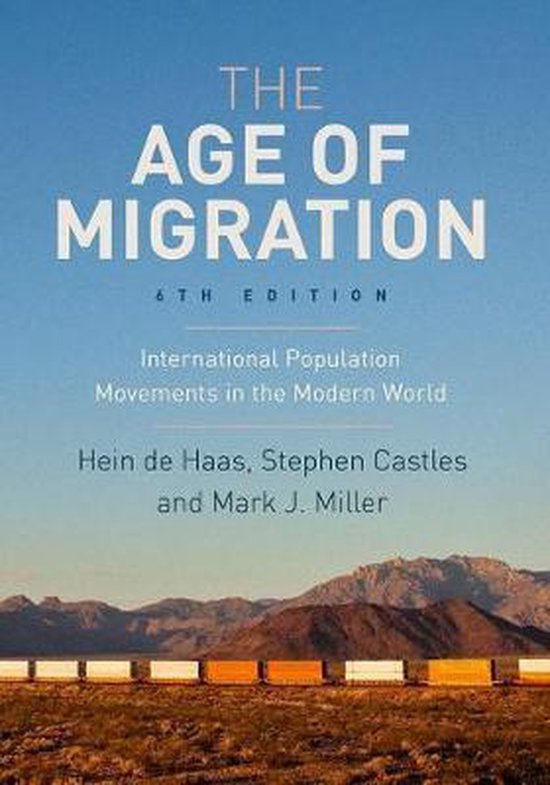Chapters 2 - 14
Chapter 2: Categories of Migration
Migration =
A change of residency across administrative borders (municipalities, provinces, national states)
Human mobility =
Refers to all forms of human movement outside of their direct living place and social environment
Non-migratory mobility =
All forms of mobility that do not qualify as migration (shopping, tourism)
Internal migrants =
When migrants move within countries
International migration =
If migration involves the crossing of a border between states
Any person who changes country of usual residence
Change in culture and social environment
Home-host terminology
Can reflect guest workers who are welcomed, but are also expected to leave + thus cannot claim
rights
Becomes problematic if it reveals ideas in which the notion of ‘home’ is unchangeable.
Sending and receiving countries
Can be problematic because of the assumed passivity of the migrants
Reveal a perception of the world in which states can and should organize on who could leave and
come (ignores the perspectives of the migrants)
But, the governments have played an important role in shaping migration patterns
‘Origin’ and ‘destination’ countries seems less problematic
Migration motives
Labor, family, student and business
Migrants have often multiple motives for migrating
They can change overtime
Forced migration: refugees and asylum-seekers
People fleeing violence and oppression
Refugee migration can be seen as forced migration, other forms are voluntary
Asylum seeker =
A person who has applied for refugee status and is still awaiting a decision
Non-refoulement =
This protects asylum seekers from return to countries where they may fear persecution
Return is only possible if refugee status determination procedures have established that an
asylum request is not be founded.
The legal basis on which refugees gain access to residency status is a humanitarian one and is
enshrined into international humanitarian law
Illegal or legal
According to classical jurisprudence, a person cannot be illegal
But, the legal status of migrants does matter to their lives and decisions.
, Instead of the words legal and illegal: unauthorized, undocumented and irregular
Lesson: always be critical and careful in the use of categories
Problems those words:
Irregular:
- Irregular migration has become the norm rather than the exception
Unauthorized/undocumented:
- it is an objective term, but problems with defining those words too
Smuggling and trafficking
Human smuggling =
It refers to the use of paid or unpaid migration intermediaries to cross borders without authorization
(by land, by sea and air)
Human trafficking =
It is the recruitment or transportation of persons by means of the threat or use of force.
Involves an element of exploitation, which sets it apart from smuggling
It is not necessarily related to migration
Climate refugees
Environmentalists claimed that effects of global warming will lead to big population
displacements. 5 reasons to be skeptical on this idea:
1. People can use adaption strategies (flood defenses)
2. In cases of floods the majority of people will move over short distances (village/town)
3. Those displacements will be temporarily, because most people wish to return home
4. People in poorer countries don’t have the resources to move over large distances
5. Those processes can deprive vulnerable people to travel over large distances and they find
themselves trapped at home
Unlikely that climate change will lead to mass migration form ‘South’ to ‘North’
Depoliticization = strategies that remove the political dimension from a social issue. Political
issues affect the vulnerability of people and their resilience with environmental and other stresses
Chapter 3: theories of migration
Migration + settlement are long-term processes
Economic development and better education in poor countries initially increases migration
Highest amount of internal and international migration is in industrializing countries
Macro level (large-scale social processes)
Part of broader process of development and social transformation (society is changing)
Political economy, labor market dynamics, interstate relationships, state efforts for control
(stimulate certain group of migration, poor or rich)
Micro level (small-scale interactions)
Migration as a function of capabilities and aspirations
Individual beliefs, practices and family ties
Meso level (in between)
What impacts the continuation of migration (group level)
Migrant networks, immigrant communities
Distinction between theories
Theories on the causes of migration processes
- Functionalist theories
- Historical-structural theories
, - Dual labor market theory, NELM
- Migration transition theories
- Aspirations-capabilities model
- Migration system theory
Theories on the impact of migration for sending and receiving countries
- Processes of migration settlement and incorporation
- Ethic
Two main paradigms (directions)
Functionalist theories
- Sees society as a system of interdependent parts (individuals)
- Treats migration as positive phenomenon, an increasing productivity, creating greater
equality
Historical-structural theories
- Sees migration as an exploitation mechanism (neo-Marxist roots)
- Economic and political power is unequally distributed: inequality
- Migration provides cheap labor, causes a brain drain
Functionalist theories
1. Push-pull models
Identify economic, environmental and demographic factors which push people out of
places and pull them into destination places.
- Assumes individual and rational choice
- Assumes that volume of migration can be predicted as a linear function distance,
population size and economic opportunities
- Tends to create a stereotypical North vs South world view
- Linkages and relative importance between different factors unclear
Push factors: poverty, fear, unemployment
Pull factors: environmental, social, political, economic
2. Neo-classical migration theory
Assumes that social forces tend toward equilibrium
- Sees migration as a function of geographical differences in the supply and demand for labor
- Micro-level: migrants are expected to go where they can be most productive + earn most
money
- Macro-level: sees migration as process which optimizes the allocation of production factors
- This theory started as a theory focusing on rural-urban migration
- Social and financial costs added later
3. Human capital theory
Alternative approach which sees migration as an investment that increases the
productivity of human capital (knowledge & skills)
- Focusses on improvement of knowledge and skills
- Theory explains the selectivity of migration
- Low-skilled migrants nearby and specialized migration tent to move further


